Click on images to enlarge

infestation (Photo: Sheldon Navie)
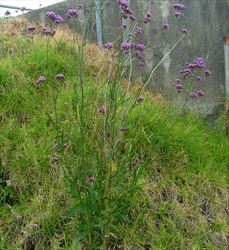
habit (Photo: Sheldon Navie)

stem, with branches in the forks of the paired upper leaves (Photo: Rob and Fiona Richardson)
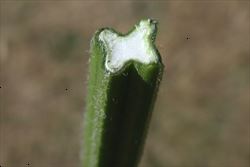
close-up of four-angled stem (Photo: Rob and Fiona Richardson)

young flower clusters (Photo: Rob and Fiona Richardson)
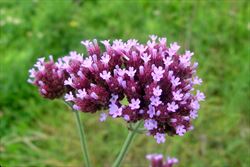
dense clusters of small tubular flowers (Photo: Sheldon Navie)
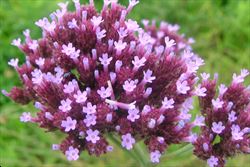
the flowers are borne above the tops of the flowering branches (Photo: Sheldon Navie)

close-up of old flower cluster showing the long stiff hairs and short sticky hairs on the stalk, bracts and sepals (Photo: Jose Hernandez at USDA PLANTS Database)

the larger flowers of veined verbena (Verbena rigida) are borne in dense clusters at the tips of elongated branches (Photo: Sheldon Navie)

the small flowers of seashore verbena (Verbena litoralis) are borne in very narrow, elongated clusters (Photo: Sheldon Navie)
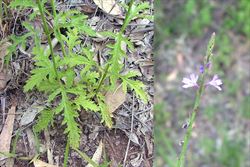
native verbena (Verbena gaudichaudii) with deeply-divided lower leaves and loose, very elongated, flower clusters (Photo: Sheldon Navie)

Verbena macrostachya, another similar native species with very elongated flower clusters (Photo: Sheldon Navie)

close-up of 'seeds' (Photo: Jose Hernandez at USDA PLANTS Database)
Scientific Name
Verbena bonariensis L.
Synonyms
Verbena bonariensis L. var. conglomerata Briq.Verbena bonariensis L. var. bonariensis
Family
Verbenaceae
Common Names
Argentine vervain, Brazilian verbena, cluster flower vervain, cluster flowered vervain, purple top, purple top verbena, purple verbena, purpletop, purple-top verbena, purpletop verbena, purple-top vervain, purpletop vervain, South American verbena, South American vervain, square weed, tall verbena, tall vervain, verbena, verbena on a stick, wild verbena
Origin
Native to South America (i.e.
Naturalised Distribution
A very widespread species that is particularly common in the eastern parts of Australia. It is most common in south-eastern Queensland, eastern New South Wales, the ACT and eastern Victoria. It is also relatively common or scattered in other parts of Queensland, New South Wales and Victoria, and is also naturalised south-eastern South Australia and south-western Western Australia. Also naturalised on Lord Howe Island and Norfolk Island.
Widely naturalised overseas, including in tropical and southern Africa, temperate Asia, North America (i.e. Canada and the USA), the Caribbean, Papua New Guinea, New Zealand and on some Pacific islands (e.g. Fiji, New Caledonia and Hawaii).
Habitat
A common weed of roadsides, pastures, grasslands, open woodlands, riparian vegetation, crops, orchards, gardens, disturbed sites and waste areas in warmer temperate, sub-tropical and occasionally also tropical environments.
Habit
A long-lived (i.e. perennial) herbaceous plant with upright (i.e. erect) stems usually growing 60-150 cm tall, but occasionally reaching up to 2 m in height. It sometimes develops a slightly woody base.
Distinguishing Features
- a long-lived herbaceous plant with upright stems growing 60-200 cm tall.
- its stems are square in cross-section and bear pairs of toothed leaves with rough surfaces.
- these stems are topped with branched, slightly-elongated spikes of small purplish or bluish coloured flowers.
- the small tubular flowers are densely clustered, and noticeably longer than the sepals.
- the open flowers are mostly borne above the tips of the flower spikes.
Stems and Leaves
The stems are square in cross-section (i.e. quadrangular) and roughly hairy (i.e. scabrous).
The oppositely arranged leaves are stalkless (i.e. sessile) with bases that slightly clasp the branches. They have elongated (i.e. lanceolate), narrowly oval (i.e. elliptic) or oblong blades (4-22 cm long and 6-70 mm wide) with pointed tips (i.e. acute or acuminate apices). Their margins are irregularly toothed, particularly towards the tip of the leaf blade. The upper surfaces of the leaves, like the stems, are coarsely hairy and rough to the touch (i.e. scabrous), while their undersides are densely softly hairy (i.e. tomentose).
Flowers and Fruit
The numerous small tubular flowers are densely arranged into branched, finger-like, clusters at tips of the stems. These clusters (i.e. corymbs) are made up of 4-10 slightly-elongated spikes 1-4 cm long. The stalks (i.e. peduncles) of these clusters and the small bracts below each flower are covered with short sticky (i.e. glandular) hairs as well as longer stiff hairs. Each flower has five small sepals (2.5-3.5 mm long) that are fused together at the base into a tube (i.e. calyx tube). The five bluish, purple or lavender-pink petals are also fused together into a tube (i.e. corolla tube) about twice as long as the sepals (6-7 mm long), but their tips are separated into five spreading petal lobes (about 2 mm long). Flowering occurs mainly during late spring, summer and early autumn (i.e. from October to March).
The small fruit separate into four 'seeds' (i.e. mericarps or nutlets) when mature. These 'seeds' (1.5-1.8 mm long) are elongated in shape and usually brown in colour.
Reproduction and Dispersal
Purpletop (Verbena bonariensis) reproduces mainly by seed.
The seeds may be dispersed by animals (i.e. externally), by wind, or in water. They may also be spread in contaminated agricultural produce.
Environmental Impact
Purpletop (Verbena bonariensis) is regarded as an environmental weed in Victoria, New South Wales, Queensland, Tasmania and the ACT.
Legislation
Not declared or considered noxious by any state government authorities.
Similar Species
Purpletop (Verbena bonariensis) is extremely similar to Verbena incompta, which is also known as purpletop, and these two species have often been confused. They can be separated by the following differences:
- Verbena bonariensis has tubular flowers that are about twice as long as their sepals (6-7 mm long). The tips of these flowers are borne well above the tops of the flowering branches. Its flower stalks, bracts, and sepals are all covered in sticky hairs (i.e. glandular) and its 'seeds' (i.e. mericarps) are relatively large (1.5-1.8 mm long).
- Verbena incompta has tubular flowers that are scarcely longer than their sepals (about 2.5-3.5 mm long). The tips of these flowers are borne below or at about the same height as the tops of the flowering branches. Its flower stalks, bracts, and sepals are not covered in sticky hairs (i.e. glandular) and its 'seeds' (i.e. mericarps) are relatively small (1.3-1.5 mm long).
Purpletop (Verbena bonariensis) is also relatively similar to other weedy and native verbenas (Verbena spp.), including native verbena (Verbena gaudichaudii), seashore verbena (Verbena litoralis), veined verbena (Verbena rigida), trailing verbena (Verbena supina) and Mayne's pest (Glandularia aristigera). An expert should be consulted for accurate identification of verbenas, however the most common and widespread species can be distinguished by the following differences:
- purpletop (Verbena bonariensis) is an upright (i.e. erect) plant (60-200 cm tall) with stalkless (i.e. sessile) leaves that have sharply-toothed (i.e. serrate) margins. Its small flowers are very densely clustered in short spikes (1-4 cm long).
- native verbena (Verbena gaudichaudii) is an upright (i.e. erect) plant (about 1 m or more tall) with shortly-stalked (i.e. petiolate) leaves. The lower stem leaves are lobed or deeply-divided (i.e. pinnatisect) while the upper stem leaves are narrower and less divided. Its small flowers are loosely clustered in very elongated spikes (up to 30 cm long).
- seashore verbena (Verbena litoralis) is an upright (i.e. erect or ascending) plant (about 1 m or more tall) with shortly-stalked (i.e. petiolate) leaves that have sharply-toothed (i.e. serrate) margins. Its small flowers are relatively densely clustered in elongated spikes (4-12 cm long).
- veined verbena (Verbena rigida) is a sprawling (i.e. decumbent) plant (20-40 cm tall) with stalkless (i.e. sessile) leaves that have sharply-toothed (i.e. serrate) margins. Its flowers are densely clustered in short spikes (1-5 cm long).
- trailing verbena (Verbena supina) is a sprawling or upright (i.e. decumbent to erect) plant (10-50 cm tall) with shortly-stalked (i.e. petiolate) leaves that have deeply-divided (i.e. pinnatisect) margins. Its relatively small flowers (about 3 mm long) are relatively densely clustered in elongated spikes (up to 10 cm long).
- Mayne's pest (Glandularia aristigera) is a sprawling (i.e. prostrate or decumbent) plant (up to 30 cm tall) with shortly-stalked (i.e. petiolate) leaves that have deeply-divided (i.e. pinnatisect) margins. Its relatively large flowers (about 11-14 mm long and 10 mm across) are densely clustered in short spikes (less than 4 cm long).

